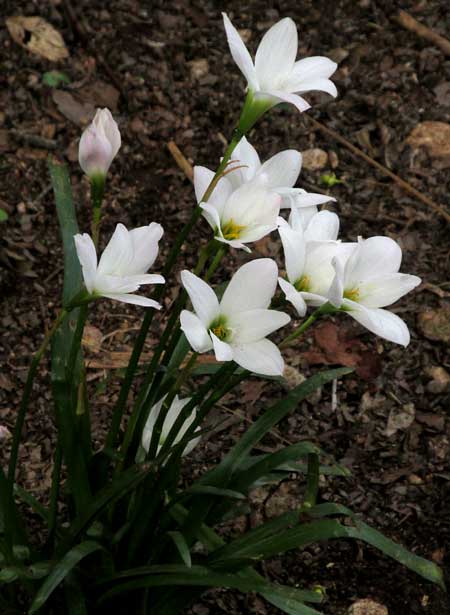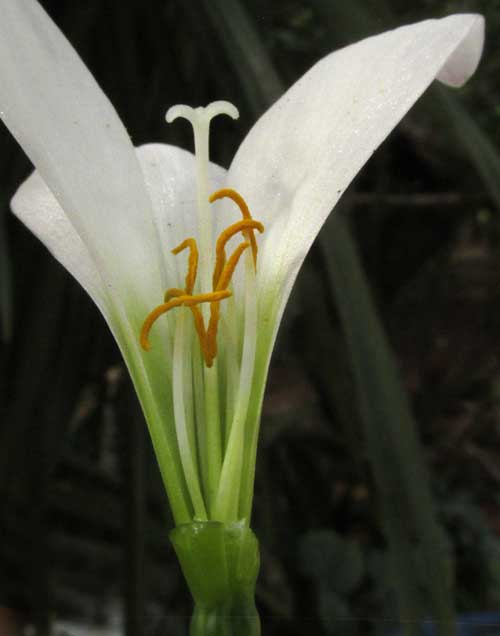Excerpts from Jim Conrad's
Naturalist Newsletter
from the May 17, 2018 Newsletter issued from Rancho Regenesis in the woods ±4kms west of Ek Balam Ruins; elevation ~40m (~130 ft), N~20.876°, W~88.170°; central Yucatán, MÉXICO
RAIN LILIES
This year the rainy season arrived several weeks earlier than normal, breaking the trend of recent years of arriving progressively later. This probably explains the blossoming of some eight-inch-tall (20cm), ornamental flowers planted along the trail to the hut, shown below:

The blossoms looked familiar, but the tufts of leaves somehow seemed out of order, so maybe this was a species I'd not seen of a known genus. To help with identification, I tore open a blossom to reveal anatomical features, shown below:

First, at the picture's very bottom, notice how the green part constricts and then enlarges. These are the features of a flower with an inferior ovary -- where the petals or petal-like parts and sexual parts arise atop the ovary, not at the ovary's base, as in superior ovaries. This is important because despite these plants looking like members of the Lily Family, species in that family nearly always have superior ovaries, while inferior ovaries are typical of the closely related Amaryllis Family.
So, feeling around in the soil and finding that the leaves and stem arose from bulbs, and seeing that no leaves arose from the stem, or "scape," bearing the single blossom, that the ovary contained numerous ovules instead of a few, that lobes of the corolla-like perianth united at their base into a tube, that the golden anthers were affixed to their white filaments at the middle of their backs ("medianly dorsifixed") -- note the anther lying ±horizontally atop its filament -- and that the stamens were of two lengths, not four, the plant was revealed to be a member of the genus Zephyranthes, of the Amaryllis Family. And we've seen Zephyranthes species before, but only in the wild.
You might enjoy seeing variations on the Zephyranthes theme by reviewing two species encountered in Texas, at www.backyardnature.net/n/h/rainlily.htm and www.backyardnature.net/n/h/rainlil2.htm and a yellow-flowered one here in the Yucatan, at www.backyardnature.net/mexnat/zephyran.htm
All these species are called rain lilies. Our current planted ornamental is, too. It's ZEPHYRANTHES CANDIDA, native to Argentina, Chile and Uruguay. The MissouriBotanicalGarden.Org website for this species describes it as an annual when planted up north, but down here ours have been coming up at the beginning of the rainy season for several years.
You might enjoy reviewing several ornamental Zephyranthes species profiled at the PacificBulbSociety.Org website.